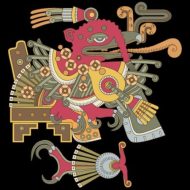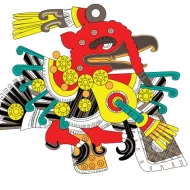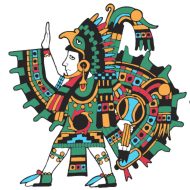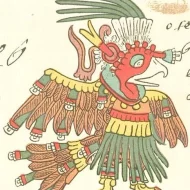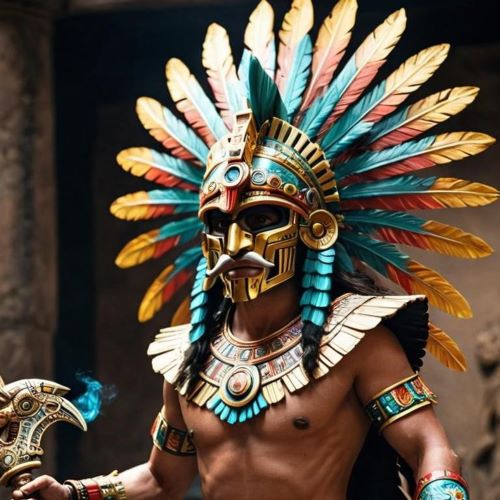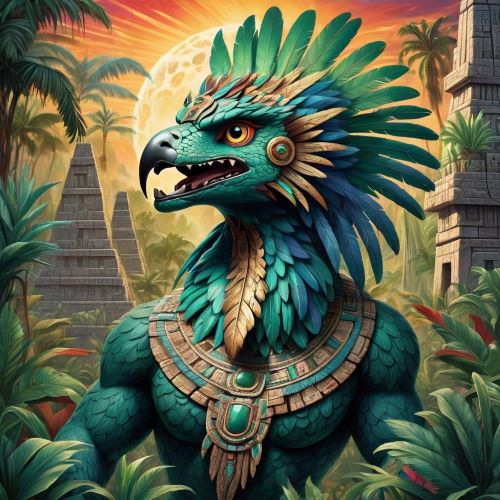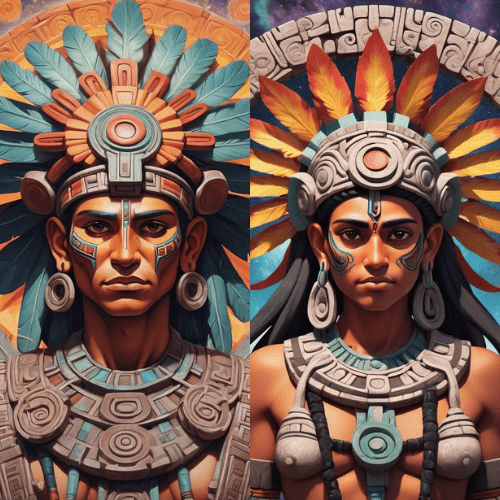Chalchiuhtotolin : The Turkey God
Listen
At a glance
| Description | |
|---|---|
| Origin | Aztec Mythology |
| Classification | Gods |
| Family Members | Xiuhtecuhtli (Father), Chalchiuhtlicue (Mother), Xolotl (Brother) |
| Region | Mexico |
| Associated With | Turkey, Jade, Magic, Disease |
Chalchiuhtotolin
Introduction
Chalchiuhtotolin, commonly known as the “Jade Turkey,” stands as a prominent figure within Aztec mythology, despite its association with disease and pestilence. In the intricate tapestry of Aztec beliefs, where gods oscillated between creation and destruction, soared amidst celestial bodies, and lingered in the shadows of the underworld, Chalchiuhtotolin emerges as a distinctive entity. This avian deity, adorned with feathers resembling precious stones, encapsulates both beauty and terror, weaving a multifaceted narrative of disease, chaos, and potent magic.
Revered and feared by the ancient Aztecs, Chalchiuhtotolin, the feathered serpent god, wielded influence over diverse realms of life and death. Its significance within Aztec mythology transcends its association with illness, holding cultural and symbolic importance that adds layers to the intricate cosmology of the ancient civilization. Chalchiuhtotolin, whose name translates to “Precious Stone Turkey” or “Jade Turkey” in Nahuatl, presided over the domain of illness and pestilence. Yet, his character transcended a mere embodiment of disease. He was a harbinger of chaos, a symbol of powerful sorcery, and a nahual (animal form) of the enigmatic Tezcatlipoca, the god of night, magic, and the jaguar.
Physical Traits
Chalchiuhtotolin is frequently illustrated as a turkey adorned with exquisite jade markings and obsidian arrows, highlighting its divine nature. These depictions serve as a visual manifestation of the deity’s power and purpose, emphasizing its sacred significance. The portrayal of Chalchiuhtotolin in various artworks and descriptions speaks volumes about the Aztec people’s reverence for this god and their profound grasp of the interconnectedness between divine entities and the human experience.
True to its name, Chalchiuhtotolin was predominantly represented as a turkey—a revered bird in Aztec culture. However, this was no ordinary fowl. Its feathers radiated with the brilliance of jade, symbolizing preciousness and the dualistic forces of nature, capable of both giving and taking life. In artistic renditions, Chalchiuhtotolin is depicted with wings outstretched, poised for flight, or hunched over with claws gleaming ominously in silver, hinting at its darker aspects. The deity’s eyes, rendered in shades of black or white, mirror the inherent duality within its being—a potential for both healing and harm.
Family
While comprehensive information about Chalchiuhtotolin’s familial connections is scarce, there are speculations surrounding potential ties between Chalchiuhtotolin and Tezcatlipoca, another significant deity in Aztec belief. Some sources propose the intriguing notion that Chalchiuhtotolin might be an aspect or alias of Tezcatlipoca. According to certain accounts, Chalchiuhtotolin was acknowledged as the offspring of Xiuhtecuhtli, the fire god, and Chalchiuhtlicue, the goddess of fresh water.
This lineage positioned him at the nexus of formidable forces, with fire embodying both creation and destruction, and water symbolizing both life and the purifying influence of chaos. Furthermore, there are sources that associate Chalchiuhtotolin with Xolotl, the twin brother of the fire god and the deity presiding over death and fire.
Other names
In addition to its designation as the “Jade Turkey,” Chalchiuhtotolin is also known as the “Jewelled Fowl.” Another appellation for this deity is the “Precious Owl.” Chalchihuihtotolin, denoted as the “Jewelled Fowl,” underscores its precious and adorned manifestation. It is also recognized as Tezcatlipoca’s nahual, underscoring its role as the animal form of the formidable deity Tezcatlipoca. Furthermore, it is referred to as the “Precious Night Turkey,” emphasizing its association with darkness and nocturnal forces.
Powers and Abilities
Chalchiuhtotolin serves as a symbol of formidable sorcery, with Tezcatlipoca, assuming the guise of Chalchiuhtotolin, having the ability to entice humans towards self-destruction. Despite this ominous aspect, the deity possesses the unique capability to purify individuals, absolving them of guilt and altering their fates. In its role as the god of disease and pestilence, Chalchiuhtotolin exerts immense influence over the well-being of mortals, capable of unleashing epidemics that sweep through communities, leaving sickness and death in their wake. Often associated with natural disasters like floods and earthquakes, the deity solidifies its image as a harbinger of chaos and disruption.
However, Chalchiuhtotolin’s powers extend beyond sheer destruction. The deity is endowed with potent magical abilities, enabling the manipulation of fate and the shaping of events. This association with Tezcatlipoca, the master of sorcery, underscores Chalchiuhtotolin’s expertise in the arcane arts, revealing a multifaceted nature that encompasses both malevolent and benevolent forces.
Modern Day Influence
While contemporary insights into the modern-day influence of Chalchiuhtotolin remain limited, the veneration for this deity and the profound acknowledgment of the interconnectedness between divine entities and the human experience continue to resonate in the cultural practices of indigenous communities. A more in-depth exploration is warranted to understand the implications and interpretations embedded in these artistic representations. Chalchiuhtotolin’s presence extends into present-day Mexican art and literature, serving as a symbol of enduring natural forces and the delicate equilibrium between well-being and affliction.
In certain indigenous communities, Chalchiuhtotolin retains reverence as a potent deity, with offerings made to appease him and safeguard against disease. Furthermore, his association with magic and transformation echoes in contemporary interpretations of Mesoamerican mythology, providing inspiration for artists and storytellers to delve into the multifaceted nature of this enigmatic god. As the imagery of Chalchiuhtotolin persists in modern contexts, there exists a dynamic interplay between tradition and reinterpretation, allowing for a continued exploration of the deity’s significance in our evolving cultural landscape.
Related Images
Frequently Asked Questions
What is lorem Ipsum?
I am text block. Click edit button to change this text. Lorem ipsum dolor sit amet, consectetur adipiscing elit. Ut elit tellus, luctus nec ullamcorper mattis, pulvinar dapibus leo.
What is lorem Ipsum?
I am text block. Click edit button to change this text. Lorem ipsum dolor sit amet, consectetur adipiscing elit. Ut elit tellus, luctus nec ullamcorper mattis, pulvinar dapibus leo.
What is lorem Ipsum?
I am text block. Click edit button to change this text. Lorem ipsum dolor sit amet, consectetur adipiscing elit. Ut elit tellus, luctus nec ullamcorper mattis, pulvinar dapibus leo.
What is lorem Ipsum?
I am text block. Click edit button to change this text. Lorem ipsum dolor sit amet, consectetur adipiscing elit. Ut elit tellus, luctus nec ullamcorper mattis, pulvinar dapibus leo.
What is lorem Ipsum?
I am text block. Click edit button to change this text. Lorem ipsum dolor sit amet, consectetur adipiscing elit. Ut elit tellus, luctus nec ullamcorper mattis, pulvinar dapibus leo.

